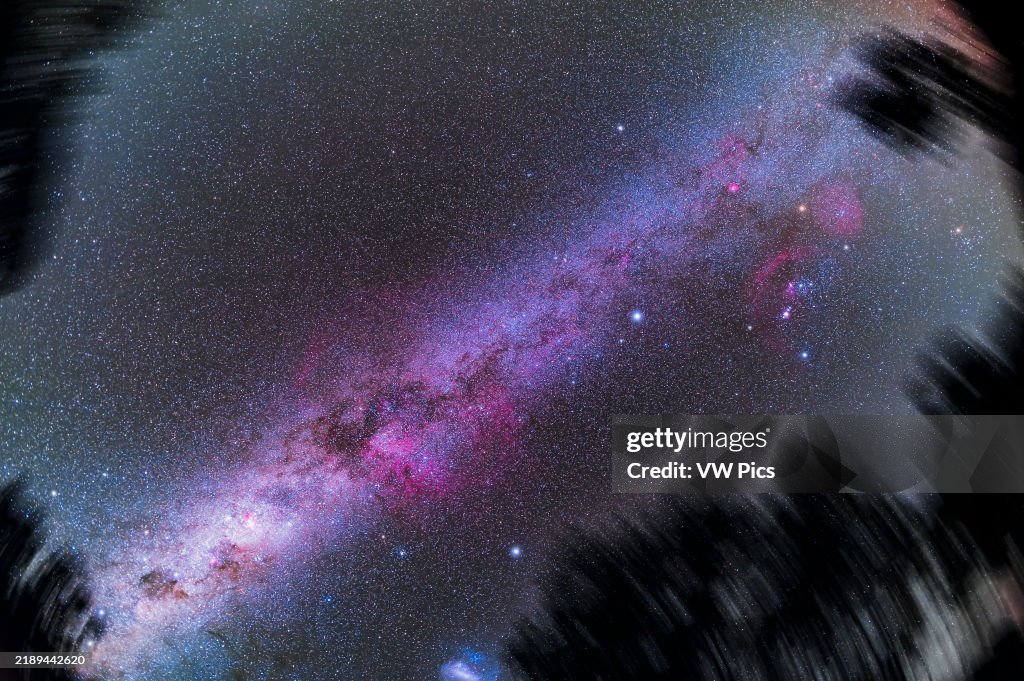Southern Milky Way from Crux to Orion
This is a wide-angle view of the southern Milky Way, here from Carina and Crux at lower left up to Orion and Monoceros at upper right. This was shot from latitude 31° S on an austral autumn night, March 3, 2024. The two brightest stars in the night sky are in the frame: Sirius right of centre and Canopus at bottom. In the centre are the constellations of Puppis and Vela, marked by the large circular Gum Nebula complex, a supernova remnant. The image was processed to enhance the pink and red nebulosity in this rich area of sky, around Orion at top and in the Vela-Puppis area. The image demonstrates just how much brighter the Milky Way is in Carina and Crux at lower left than it is farther north in Puppis, Canis Major and Monoceros. Taken with a filter-modified Canon Ra camera, but no filter per se was used other than a clip-in Astronomik UV/IR-Cut filter to reduce the haloes on bright stars that the Ra is prone to. Oddly, using this filter also improves the off-axis sharpness of the lens used here, an 11mm TTArtisan full-frame fish-eye, wide open at f/2.8, but re-focused closer than infinity to obtain sharp stars with the clip-in filter. All on the MSM Nomad tracker, for a stack of 10 x 3-minute exposures at ISO 800. Taken on a perfect night March 3, 2024 from Mirrabook Cottage near Coonabarabran, NSW, Australia, near the Warrumbungles National Park. (Photo by: Alan Dyer/VWPics/Universal Images Group via Getty Images)

KÖP EN LICENS
Hur får jag använda den här bilden?
kr 2,800.00
SEK
Getty ImagesSouthern Milky Way from Crux to Orion, Nyhetsfoto Southern Milky Way from Crux to Orion Få förstklassiga, högupplösta nyhetsfoton på Getty ImagesProduct #:2189442620
Southern Milky Way from Crux to Orion Få förstklassiga, högupplösta nyhetsfoton på Getty ImagesProduct #:2189442620
 Southern Milky Way from Crux to Orion Få förstklassiga, högupplösta nyhetsfoton på Getty ImagesProduct #:2189442620
Southern Milky Way from Crux to Orion Få förstklassiga, högupplösta nyhetsfoton på Getty ImagesProduct #:2189442620kr4,200kr1,100
Getty Images
In stockObservera: bilder som visar historiska händelser kan innehålla teman eller ha beskrivningar som inte återspeglar den aktuella förståelsen. De tillhandahålls i ett historiskt sammanhang. Läs mer.
INFORMATION
Begränsningar:
Kontakta ditt lokala kontor för all kommersiell eller marknadsföringsrelaterad användning.
Upphovsman:
Redaktionell fil nr:
2189442620
Samling:
Universal Images Group
Datum skapat:
03 mars 2024
Uppladdningsdatum:
Licenstyp:
Releaseinformation:
Saknar release. Mer information
Källa:
Universal Images Group Editorial
Objektnamn:
1020_08_ady-june2024-124
Högsta tillåtna filstorlek:
6710 x 4460 bpkt (56,81 x 37,76 cm) - 300 dpi - 14 MB
- Betelgeuse - Stjärna,
- Astronomi,
- Astronomisk fotografering,
- Australien,
- Carinanebulosan,
- Clip-in - Hårförlängning,
- Emission Nebula,
- Fotografi - Bild,
- Färgbild,
- Galax - Stjärnfält,
- Himmel,
- Horisontell,
- Lång exponeringstid,
- Mänskligt intresse,
- Natt,
- Nebulosa,
- New South Wales,
- Observatorium,
- Orion,
- Orionnebulosan,
- Rymd och astronomi,
- Sirius,
- Spanare,
- Stjärnbild,
- Stora hunden,
- Teleskop,
- Vidvinkel,
- Vinter,
- Vintergatan,
- Världsrymden,
- Warrumbungles,